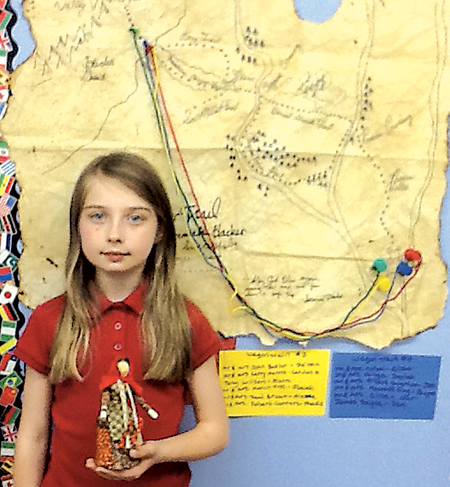WESTWARD HO: 4TH GRADERS STUDY THE WESTWARD EXPANSION – Around The Frame
 This year the 4th grade team at Waynedale Elementary devised an interactive, cross-curricular (writing, social studies and math) unit to study the Westward Expansion in such a manner to make it relevant to the students.
This year the 4th grade team at Waynedale Elementary devised an interactive, cross-curricular (writing, social studies and math) unit to study the Westward Expansion in such a manner to make it relevant to the students.
According to teacher Lauri Phillips, “The students were given a list of supplies to pick from to take on their travels. They were told how much each item weighed and the total weight that could be packed into their wagon. Without much guidance they picked their supplies. Along the trip they would sometimes come upon a river swollen by rain and have to lighten their wagon to a predetermined amount of weight. The settlers faced many hardships. Some of them included crossing flooded rivers, snakebites, running out of food and water during their travels. The students were split into four different wagon trains with six wagons in each train. They researched the various westward routes and made a map of them. The “pioneers” would then have to make decisions about which trail to follow, whether to cross a river or backtrack and other difficult decisions as a group and suffer the consequences when thing went array.”
As part of the math portion of the unit the students were asked to create a quilt based on geometric shapes with repeated patterns: Perimeter, area, symmetry and fractions came into play as they designed them. Quilts made up entirely of squares, rectangles, triangles and hexagons come to mind as classic one-block patterns such as pyramid, trip around the world, and grandmother’s flower garden.
During the three-week study unit, Mrs. Phillips happened to stop by Jefferson GALA (Great Art Local Artists) located at 2545 W. Jefferson Blvd., Fort Wayne. There she saw cornhusk dolls created by Native American artist Mary Lyons. Knowing both Native American and pioneer children played with them she discussed the class project with Mary, who then volunteered to make one for the class.
Using fresh cornhusks and wetting them down to manipulate them into shape, Mary creates the traditional cornhusk body used by all cultures and fashions her dress out of period fabric scraps donated by Born Again Quilts.
According to Mary, Native American cornhusk dolls can be differentiated by tribe or locale based on the costume and the hairstyle. Mary uses horsehair for her pioneer dolls’ hair. It pleases Mary that when settlers learned the art of cornhusk doll making, they honored the Native American tradition and did not add facial features to them.
The students were amazed when Mary brought the doll to class and appreciate the research and hard work that went into making one. As Mrs. Phillips put it “The look of amazement and wonder on the children’s faces was priceless. Thank you Mary!”
Now that the school year has come to an end and the teachers are re-evaluating their curriculum, perhaps next year “art” will be included and the students will try their hands at making a traditional repeating pattern block and a cornhusk doll under the direction of Mary Lyons.
Lois Levihn is the owner of Born Again Quilts where vintage quilts, tops, blocks, vintage and reproduction fabrics are bought and sold. She also restores quilts back to life. www.bornagainquilts.com
- The Stars & Stripes Are Forever: Around The Frame - July 5, 2024
- Sam Butcher: A Life Filled With Precious Moments ~ Around The Frame - June 7, 2024
- Aunt Dora & Her Well-Lived Life ~ Around The Frame - May 10, 2024


